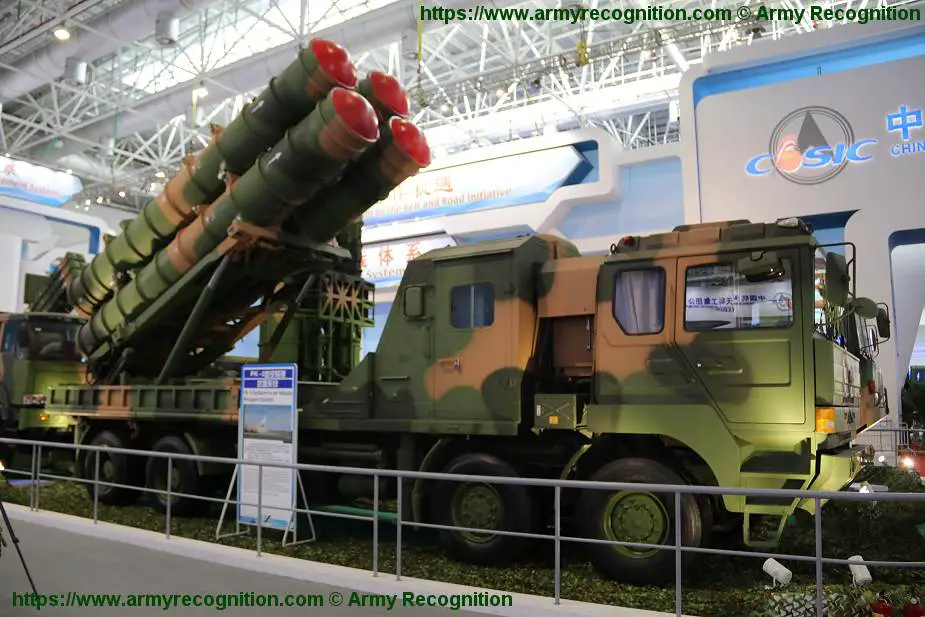Breaking news
China delivers FK-3 medium range air defense missiles to Serbia.
According to Mike Yeo in Defense News, China has delivered anti-aircraft missile systems to Serbia as part of a contract this country signed with China that also included drones. The Chinese used an air bridge with Y-20 heavy-lift aircraft to transport the FK-3 missiles and presumably other equipment, to Serbia on April 9, 2022.
Follow Army Recognition on Google News at this link

Mobile TEL Transporter Erector Launcher unit of Chinese-made FK-3 long-range air defense missile system. (Picture source: Army Recognition)
Chinese Foreign Affairs Ministry spokesperson Zhao Lijian told reporters on April 11 that the delivery was part of the two countries’ annual cooperation plan, does not target any third parties and “has nothing to do with the current situation”. Zhao gave no further details, Mike Yeo reports.
It is believed the delivery, which took place over the weekend, was for a battery of FK-3 medium-range, road-mobile, surface-to-air missiles. Serbia had signed for the missiles in 2020 under a contract that also included the China Aerospace Science and Technology Corporation-made CH-92 armed drone. Serbian President Aleksandar Vučić did not confirm the delivery of the FK-3 when asked on April 10, although he added in remarks reported by The Associated Press that he would present “the newest pride” of the Serbian military on Tuesday or Wednesday.
The HQ-22 is a medium/long-range semi-active radar homing/radio-command guidance surface-to-air missile. It was developed as the second generation of the HQ-12 missile. The HQ-22's manufactured by Jiangnan Space Industry, also known as Base 061, part of China Aerospace Science & Industry Corporation Limited (CASIC). In 2014, a downgraded form of the missile known as the FK-3 was revealed, targeting export customers. In Zhuhai Airshow 2016, the HQ-22 was first publicly revealed as an improved version of the FK-3. In 2017, the HQ-22 entered service in the People's Liberation Army and has rapidly become one of the main missiles used for air defense. In August 2020, it was announced that Serbia had purchased the FK-3, surprising a majority of Russian media that had expected Serbia to purchase the Russian-made S-300 instead. It was the first time that any Chinese medium and long-range SAM had been exported to a European country. In April 2021, it was reported that HQ-22s were deployed by the PLA near Indian territory in the eastern Ladakh area.
The FK-3 retains the HQ-22 domestic version’s top speed of Mach 6, although its maximum range has been reduced from 170 km to 150 km (105 miles to 93 miles). It can reportedly engage ballistic and cruise missiles, aircraft, helicopters, and UAVs. A major difference of the HQ-22 from its predecessor HQ-12 is that the HQ-22 has a new "wingless" design. The missile can use either semi-active radar homing composite guidance or radio-command guidance throughout the whole course. Initially, the missile will use semi-active radar homing guidance and in the case that it encounters strong electronic interference, will automatically change to radio-command guidance.
A typical battery of the HQ-22 system includes 1 radar vehicle and 3 launcher vehicles equipped with 4 missiles each. Each battery can supposedly engage 6 air targets simultaneously. The launcher vehicle is based on an 8x8 chassis manufactured by the Hanyang Special Purpose Vehicle Institute. The HQ-22 launches its missiles at an angle, unlike the HQ-9 and HQ-16 which launch their missiles vertically.
The missile system has been widely compared to the American Patriot and Russia's mobile long-range S-300 surface-to-air missile system, and although it has a shorter range than S-300 variants such as the S-300PMU2 it is speculated to benefit from superior electronic warfare countermeasures (ECM) and superior capabilities against stealth targets at shorter ranges.

The Chinese used an air bridge with Y-20 heavy-lift aircraft to transport the FK-3 missiles and presumably other equipment, to Serbia on April 9, 2022. (Picture source: China Military Online)


























